





Published on Nov 30, 2023
In the modern era, the field of biofuel has found greater scope and importance contrasting to the depletion of fossil fuels. There has been lot of developments in regard to the production and usage of biodiesel. Biodiesel can be produced from various bio seeds such as Millettiapinnata, Pongamia, Jatropha, Neem and even from animal fats.
In India, Neem tree is widely grown and termed as a divine tree due to its wide relevance in many areas of study. We shall consider aspects related to the production of biodiesel from Neem oil.
This project deals with de-pulping of neem seeds which will in turn reduce the wastage of neem oil during extraction of the same. The outer pulp of neem seeds is found to absorb oil during its extraction, so it is necessary to remove the outer pulp. The present method of removing the outer pulp is manual which is tedious and time consuming.Also, the cost of de-pulped seeds is nearly 3 times more than that of normal seeds in the market.
So, in our project, we have made an attempt to design and fabricate NEEM SEED DE-PULPING MACHINE. We have made sure that the dimension of parts come in accordance with good specification.
The main objective of our project is to make the process of neem seed de-pulping simple, time saving and also to increase the income of farmers selling neem seeds.
NEEM oil has become more attractive in the recent past owing to its environmental benefits and the facts that it is made from renewable resources. Neem oil is a renewable and potentially inexhaustible source of energy with an energetic content close to diesel fuel. Oils derived from fossils may in course of time become obsolete but not bio oils.
The neem tree one of the most versatile of India’s plants. Valued for centuries throughout tropical Asia for its multitude of medicinal and other uses. Almost all parts of a neem tree are useful. Neem is native to India and much of tropical Asia.
Neem (Azadirachta Indica) is a tree in mahogany family Meliaceae which is abundantly grown in varied parts of India. According to a rough estimate made in a quick survey conducted, India has around 140 lakhs neem trees and only 20% of seed crop is harvested due to scattered growth. The neem grows on almost all types of soils including clayey, saline and alkaline conditions. The neem tree starts yielding after 5 years.
Neem seed obtained from the tree are collected, de-pulped, sun dried and crushed for oil extraction. The seeds have 45% oil which has a high potential for the production of biodiesel.
Neem oil is generally light to dark brown, bitter and has a rather strong odour. It comprises mainly of triglycerides and large amounts of tri terpenoid compounds which are responsible for the bitter taste. It is hydrophobic in nature. The neem oil is antiseptic, antifungal, antipyretic and antihistamine. Neem oil also contains several sterols, including campesterol, beta sitosterol and stigmasterol.
Apart from being used for the production of bio fuel, the neem oil is also used in production of medicines, bio-pesticides, oil cake, manure and other agricultural products.
We, in this project only concentrate on the process and mechanism of de-pulping of neem seed.
Fabrication of a temporary model.
Initial testing and observations on temporary model.
Design of neem seed de-pulping machine.
Fabrication of neem seed de-pulping machine.
Final experimentation and result analisis.
A sample of cleaned neem seeds are soaked in water and hourly observation is done. The results of observation are as follows:
2 hours – No significant changes found
4 hours – No significant changes found
6 hours – Seeds are swollen and a bit soft
There is slow and gradual increase in rate of swelling and softening from 8 hours.
Day 1 (24 hours) – Partial removal of seed coat.
Day 2 (48 hours) – Better removal of seed coat.
Day 3 (72 hours) – Seeds become too soft and formation of oil layer is observed.
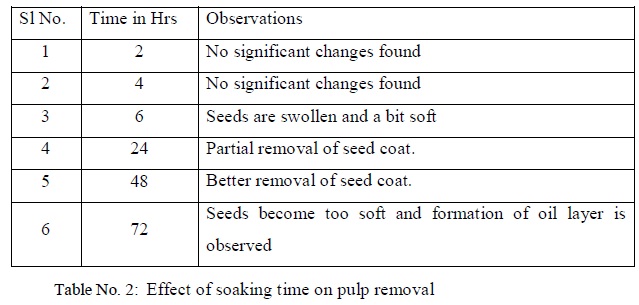
It is observed that there is a formation of oily layer when the seeds are soaked beyond 2 days, this might reduce the efficiency of neem seeds.The seeds soaked between day 1 to day 2 i.e. around 36 hours are found to be optimum for removal of seed coat.
The main objective of this experiment was to find out the most efficient soaking time. Three 1.5 kgs samples of seeds were soaked for 24, 48 and 72 hours respectively. The motor used was of ½ hp capacity and a speed of 1440 rpm was kept constant. The results of the experiment are given in table below.
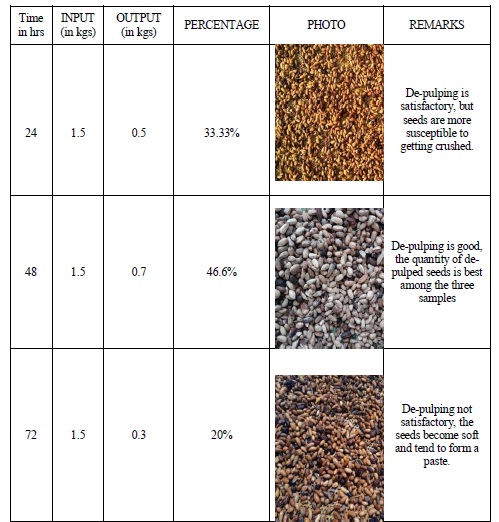
It is evident from the above table that soaking between 24-48 hours, i.e. 36 hours is best suitable for de-pulping.
The seed samples were soaked for 48 hours according to the previous results. The aim of this experiment is to observe de-pulping rate at various speeds. The results are tabulated below
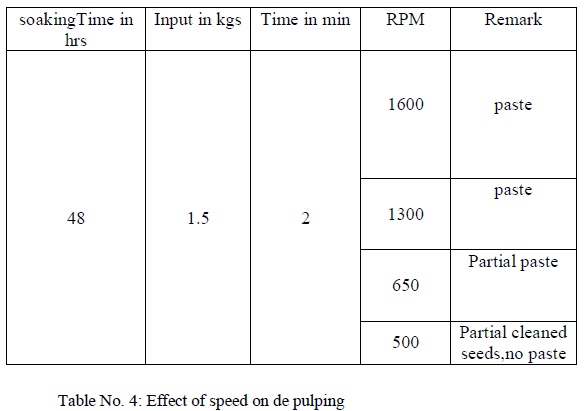
In this experiment speed was taken as a variable and all others are kept constant.The speed was measured at the bigger pulley and from that drum speed is calculated.
The bigger pulley was run at speeds of 1250,800,500 and 400 Rpm and equivalent drum speed is calculated.
Gear ratio is 25/19 = 1.315
It was observed that at spees more than 500 rpm we observed over crushing of seeds we get only paste. So it was inferred that a speed of 500 rpm provides best results.
In this experiment time was taken as a variable and all others are kept constant.
Here we observed that the 30 seconds of crushing gives very good results.
From the above two experiments it was inferred that a speed of 500 rpm and time of 30 seconds provides best results.
The main steps in fabrication are the fabrication of frame, fixing drum to the frame, fixing motor, fabrication of de pulping blade,fabrication of driver pulley,fixing driving mechanism.
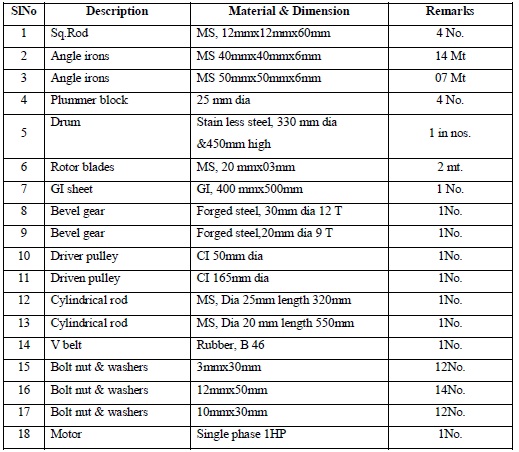
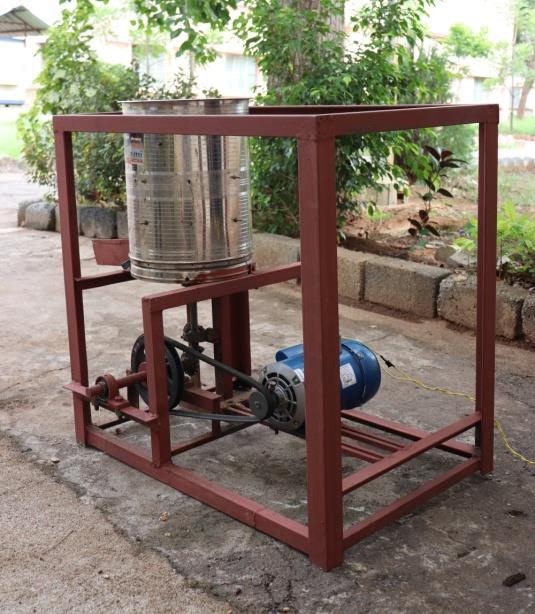
As the speed for best results was determined to be 460 rpm for continuous loading speed was kept constant and time of churning was varied.
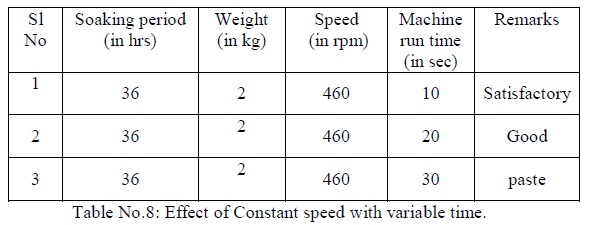
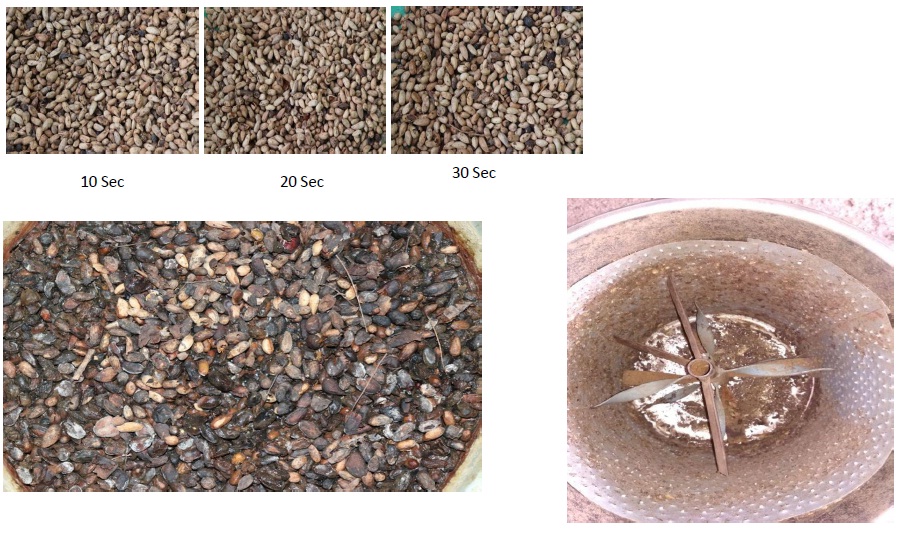
• The whole machine can be designed for one or two Kg capacity and continuous feeding instead of 10Kg capacity and hence cost can be reduced.
• A hopper can be designed for proper feeding of seeds.
• Drict drive can be designed for rotor insted of a belt drive so that capacity of the motor can be reduced hence the cost.
• A cleaning mechanism can be designed for cleaning the depulped seeds.
• An hot air drying mechanism can be designed for drying the seeds.
The experimentation work on the final model revealed a good result. Even the capacity of the machine is found satisfactory when run at 450 rpm and continuous feeding of 1.5 Kg of seeds at a time with a break of 1or 2 Sec.for each feed. The time is around 20 Sec for each load. The only drawback is the cost. Since it is designed for formers the cost should be reduced.
1. "Azadirachta indica". World Checklist of Selected Plant Families (WCSP). Royal Botanic Gardens, Kew. Retrieved 14 December 2016 –
2. Azadirachta indica". Germplasm Resources Information Network (GRIN). Agricultural Research Service (ARS), United States Department of Agriculture (USDA). Retrieved 9 June2017.
3. Encarta World English Dictionary (1999), Neem, page 1210, St. Martin's Press, New York.
4. World Checklist of Selected Plant Families, Royal Botanic Gardens, Kew, retrieved 2012- 01-06